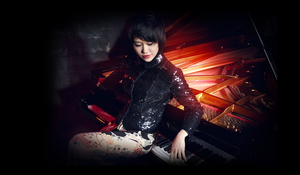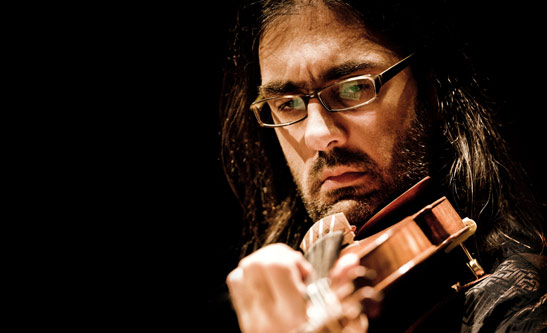Review: THE LA JOLLA MUSIC SOCIETY PRESENTS LEONIDAS KAVAKOS AND YUJA WANG at the Balboa Theatre
An Unusual and Satisfying Program of Violin Sonatas

Although they don't fill stadiums violinist Leonidas Kavakos and pianist Yuja Wang are classical music's equivalent of huge pop stars. Wang is the better-known of the two partly because of the attention she's garnered by dressing like one, surely more conservatively than Lady Gaga and Cher, but still eye-catching compared to the usual classical style. On this evening she surprised a bit with a black dress, perhaps to match Kavakos's dark dinner jacket and the seriousness of the music to follow. The unusual program included J.S. Bach's 1st and 3rd sonatas for Violin and Keyboard, Shostakovich's G Major Sonata for Violin and Piano, and Busoni's 2nd sonata for Violin and Piano. None of the more familiar works such a star duo would usually perform were in the mix.
The informative pre-concert lecturer, acknowledging the programs "ear-stretching" challenges, spent much of his time on a technical analysis of structure and the meanings of various terms such as trio sonata, tone row and ostinato. Understanding how composers work their materials to achieve the effects they're after can add to a listener's satisfaction, but analysis was a misleading prelude to the passionate music and performances to follow, beginning with Bach who once said that music exists to praise God and refresh the soul.
Bach's 3rd violin-keyboard sonata seems driven by that view. Sublime first and third

movements are combined with the lively, earthy second and fourth. Kavakos gave a nod to original performance practices with a pure tone and limited light vibrato. His tinge of original was combined with Wang's skilled use of a modern piano's range, from exquisite delicacy to considerable power. Those favoring the limited expressiveness of the harpsichord of 18th century performances are masochistic purists.
Busoni's second sonata was the longest and least familiar work on the program, and by far the most romantic. Accordingly, Kavakos adjusted to a fuller richer sound with more prominent vibrato. The first two of three movements have you wondering why the work isn't performed more often. A beautiful melody highlights the first while the second is a cheerful romp. I believe the third explains the puzzle. It includes material from the first two movements and, tying it to the concert's preceding piece, it includes a lengthy theme and variations on a Bach chorale melody. The movement consumes two thirds of the work's half-hour length, an impressive display of compositional technique, but far too long as the variations become frustratingly predictable.
The audience was quietly attentive through the first half except for a half dozen distracting sinus-driven snorts near the back of the theater that had the startling volume of an elephant attempting to clear something stuck in its trunk. Skipping the concert should have been considered.
There were fewer distractions after the intermission. Bach returned with his first sonata for violin and keyboard, Kavakos revisiting a closer-to-original Bach style while Wang again displayed her considerable expressive universe. The pianist stuck with her habit of changing dresses for the second half, this time from a short, lowcut black to a colorful full-length. Kavakos, perhaps consistent with his more conservative Bach interpretation, remained in standard garb. The bows of the pair were another interesting contrast, Kavakos's a standard one, while Wang bent at the waist, head suddenly nearly to the knees as though she were about to somersault into the audience.
Shostakovich's G Major Sonata for Violin and Piano concluded the concert. Bach's uplifting musical stories are the opposite of the Russian composer's sonata with its combination of jaunty satiric sarcasm, dark crushing sadness, and furious anger. The duo was all in with a spectacular display of technique, so good it disappeared in a full realization of the composer's intent. The audience seemed stunned to silence after the bitter violence and final quiet despair of the last two movements.
A concert of exceptional technique and interpretive power. Kavakos and Wang deserve the fame they've achieved.
Visit the the La Jolla Music Society's website for the schedule of its coming concerts.
Reader Reviews

Videos

